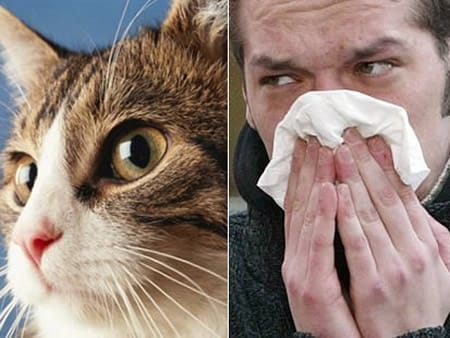Source(s): Jim Howell, Ph.D., Entomologist, The University of Georgia
Cat allergy is by far the most common pet allergy. Five percent to 10% of the general population have a distinct cat allergy and up to 40% of asthmatics are sensitive to cats.
Contrary to popular belief, the allergy-causing substance from cats is not cat hair. Although individual cats may produce varying amounts of allergen, there is no relationship between the pet’s hair length and allergen production, and although some will argue the point, there is no such thing as a nonallergic breed.
The cat allergen is found primarily in flakes of cat skin and salivia. Male cats produce more of the allergen than females. It is produced in the animal’s salivary glands and the sebaceous glands in the skin, and because cats love to groom, they deposit this protein on their fur when they lick themselves.
These microscopic allergen particles can remain airborne for a long time. They can be easily inhaled into the nose and lungs, producing an allergic response. Mattresses, sofas and carpets can contain significant allergen particles up to six months after the animal has been removed. These particles also accumulate on walls.
Symptoms
People suffering a serious cat allergy will exhibit almost immediate rhinoconjunctivitis and wheezing upon entering a room that contains a cat. Cat allergy is a common trigger for atopic eczema, an itching , scaling or thickening of the skin. Perennial allergic rhinitis – chronic or recurent sneezing and/or runny nose – is like having year-round hay fever or a permanent cold. It’s important to know that allergies have an immediate (within one hour) and delayed (two hours or longer) component. An asthmatic, for example, might notice a worsening of his or her condition the day after exposure. An asthmatic may sometimes get no acute flareup and will assume he or she doesn’t have a cat allergy. But it is very possible there is ongoing chronic inflammation in the lungs due to ongoing cat exposure.
What To Do
If you have a cat allergy, the best thing to do, of course, is to remove the cat. But many allergic cat owners would rather suffer the consequences than get rid of their pet. If so, try the following:
- Remove airborne particles as much as possible. Use an air purifier with a HEPA filter.
- Keep cats out of bedrooms or other spaces where you spend a lot of time, such as a home office.
- Vinyl or hardwood floors are preferable to carpets because they hold far less cat allergens.
- Air out the house. Opening windows and using exhaust fans can increase air exchange and decrease airborne allergens.
- Use a damp cloth to clean walls and furniture.
- Use a dust or face mask when brushing or cleaning your cat.
Reviewer(s):
- Lynwood Blackmon, CEA – DeKalb County.
- Bobby Wilson, CEA – DeKalb/Fulton Counties, The University of Georgia College of Agricultural and Environmental Sciences.
Center Publication Number: 240
- Icky Silverfish are Generally Harmless - September 24, 2013
- Menacing Mice - September 24, 2013
- Opossum Damage and Control - September 24, 2013
